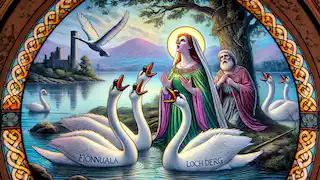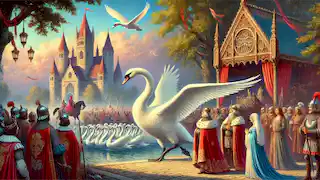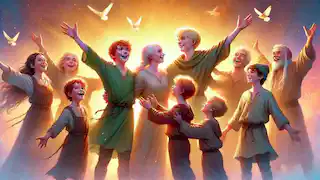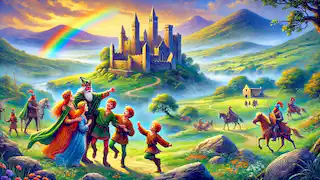The Tragic Beginning
In the ancient days of Ireland, a land of misty hills and deep forests, there was a king named Lir. He was a lord of the sea, a man of great power and noble lineage. Lir was married to a woman named Aoibh, and together they had four children: Fionnuala, the eldest and the only daughter, and three sons, Aodh, Fiachra, and Conn. The children were the joy of Lir's life, and their laughter echoed through the halls of his castle.
But fate, as it often does, took a cruel turn. Aoibh fell ill and, despite the best efforts of the kingdom's healers, she passed away, leaving Lir and the children heartbroken. The king, needing to ensure the well-being of his children, decided to remarry. He chose Aoife, the sister of his late wife, believing she would care for the children as if they were her own.
For a time, Aoife did care for the children, but as the days turned into months, jealousy began to fester in her heart. She resented the love Lir had for his children, a love that overshadowed any affection he had for her. Consumed by envy, she devised a plan to rid herself of the children and claim Lir's attention for herself.
The Curse Unleashed
One day, Aoife took the children to visit their grandfather, the High King Bodb Derg, under the pretense of giving them a change of scenery. As they traveled, she led them to a secluded lake, Loch Derg, and there, her malevolence came to fruition. Using dark magic, she cast a spell that transformed the children into swans.

With a cruel smile, she spoke the curse aloud: "You shall remain as swans for nine hundred years, spending three hundred years each on Loch Derg, the Sea of Moyle, and the Isle of Inis Glora. Only when a king from the north marries a queen from the south will the curse be broken."
Fionnuala, who had been the eldest and most protective of her siblings, now found herself in the body of a swan. She cried out to Aoife, begging for mercy, but the enchantress was unmoved. She left the children there, helpless and alone, before returning to Lir's castle with a fabricated story of their tragic demise.
When Lir received the news, he was devastated. His heart was shattered by the loss of his beloved children. The halls of the castle that once echoed with their laughter now felt cold and empty. Despite Aoife's story, Lir couldn't shake the feeling that something was amiss. He sent messengers throughout the land, but no trace of the children was found.
The First Exile
The first three hundred years were spent on Loch Derg. The children, now swans, struggled to adapt to their new forms. They retained their human voices and their memories, but the life of a swan was a harsh one. They faced the cold winters and the dangers of the wild, relying on Fionnuala's strength and wisdom to survive.
Fionnuala took on the role of their guardian, her heart heavy with sorrow but filled with determination to protect her brothers. The swans sang songs of their plight, their mournful melodies echoing across the lake and touching the hearts of all who heard them. The local people began to speak of the enchanted swans, and their story spread throughout the land.
Lir, upon learning of his children's fate, was devastated. He sought out Aoife, demanding the truth. Under the pressure of his anger and grief, Aoife confessed to her wicked deed. Enraged, Lir sought the aid of Bodb Derg, who transformed Aoife into a demon of the air, condemning her to wander the earth as a creature of the wind.
During their time on Loch Derg, the children grew accustomed to their swan forms. Fionnuala became adept at finding food and shelter for her brothers. She taught them how to navigate the waters and avoid predators. The bond between the siblings grew even stronger as they relied on each other for survival. They found solace in their shared songs and the memories of their past life.
The Sea of Moyle
The second part of their exile took them to the Sea of Moyle, a place of turbulent waters and treacherous storms. Here, the children faced even greater hardships. The sea was unforgiving, and the cold was relentless. Fionnuala's feathers became their shield against the icy winds, and her wings, though delicate, were strong enough to guide her brothers through the rough seas.

Despite the hardships, the children remained close, their bond unbreakable. They took comfort in their shared memories of their human lives and the love they had for one another. They often reminisced about their father and the happier times in the castle. Fionnuala's gentle songs and Aodh's stories kept their spirits alive.
During one particularly harsh winter, the swans found refuge on a small, rocky island. The freezing winds howled around them, and the waves crashed violently against the shore. Fionnuala huddled close to her brothers, wrapping her wings around them to keep them warm. They sang their songs softly, their voices barely audible over the storm. Despite the cold and the hunger, they drew strength from each other and endured the long, dark months.
As the years passed, the swans witnessed the changing seasons and the passage of time. They saw the arrival of new settlers on the nearby shores and heard stories of distant lands. The world was changing, but the swans remained bound by their curse, their hope resting on the prophecy that would one day free them.
The Isle of Inis Glora
The final three hundred years were spent on the Isle of Inis Glora, a place of tranquility and solitude. Here, the swans found some respite from their arduous journey. The island was peaceful, and they were able to rest and recover from their previous ordeals. They spent their days swimming in the calm waters and their nights singing songs that told the tale of their cursed fate.

As time passed, they saw the world change around them. The old gods and the ancient ways began to fade, replaced by new beliefs and new peoples. Yet, through it all, the children remained bound by the curse, their hope resting on the prophecy that would free them.
On Inis Glora, the swans found an old hermit who had taken up residence on the island. He was a kind and gentle man, living a simple life of solitude and prayer. When he heard the swans' songs, he was deeply moved by their sorrowful tale. He provided them with food and shelter, offering them companionship and solace.
The hermit told the swans stories of the new faith that was spreading across the land, a faith that spoke of forgiveness and redemption. Fionnuala listened intently, her heart filled with a new sense of hope. She began to believe that the prophecy might indeed come true and that they would one day be freed from their curse.
The Prophecy Fulfilled
Centuries passed, and the children endured their long exile with unwavering hope. One day, they heard news of a king from the north, Lairgnen, who was to marry Deoch, a princess from the south. The swans, now ancient and weary, sensed that the time of their release was near.
They made their way to the court of Lairgnen and Deoch, their swan forms weary but their spirits unbroken. When the king and queen saw the swans, they were moved by their grace and the sorrow in their song. Recognizing the fulfillment of the prophecy, Lairgnen and Deoch called upon the new Christian priests to help the children.

With prayers and blessings, the priests lifted the curse, and the swans transformed back into their human forms. However, the nine hundred years had taken their toll, and the children were now old and frail. Despite their weakened state, they were overjoyed to be reunited in human form.
The king and queen, along with the priests and the court, were in awe of the miraculous transformation. They treated the children with great reverence and care, ensuring they were comfortable and well-tended. Fionnuala, Aodh, Fiachra, and Conn shared their story with the court, recounting the details of their long and arduous journey.
The children of Lir, though freed from their swan forms, were at the end of their long lives. They had endured unimaginable hardships and had remained steadfast in their love for one another. Their story had become legend, a tale of enduring love and unwavering hope.
Fionnuala, Aodh, Fiachra, and Conn, now at peace, were baptized by the Christian priests. They passed away soon after, their spirits finally free from the curse that had bound them for so long. They were buried together, and a great cairn was erected in their memory.
Their tale spread across Ireland, and their legacy lived on in the hearts of the people. The story of the children of Lir became a symbol of resilience, love, and the power of hope, reminding generations of the enduring strength of family and the power of faith.
The Legend Lives On
Years after the children of Lir had passed, their story continued to be told around hearths and in the halls of kings. Bards and storytellers wove their tale into songs and poems, ensuring that their legacy would never be forgotten. The children of Lir became a symbol of the enduring strength of family and the resilience of the human spirit.
In the centuries that followed, Ireland faced many challenges and
changes. The arrival of new cultures and beliefs brought both conflict and growth. Yet, through it all, the story of the children of Lir remained a cherished part of the nation's heritage.
Monuments were erected in their honor, and the places they had once roamed as swans became sacred sites. Pilgrims would visit Loch Derg, the Sea of Moyle, and the Isle of Inis Glora, seeking to connect with the spirit of the children and find inspiration in their tale of perseverance and love.
Modern Reflections
In modern times, the story of the children of Lir continues to resonate with people around the world. It has been adapted into various forms of art, including literature, music, and theater. The themes of love, loss, and resilience are universal, and the tale has found a place in the hearts of many.
Educators use the story to teach lessons about empathy, courage, and the importance of family. Artists create beautiful depictions of the swans and their journey, capturing the essence of their struggle and their ultimate redemption. The children of Lir have become more than just a legend; they are a symbol of the enduring human spirit.
The Eternal Bond
The children of Lir's bond was unbreakable, even in the face of unimaginable adversity. Their love for each other gave them the strength to endure the long centuries of their exile. Fionnuala, as the eldest, took on the role of protector and guide, her wisdom and compassion leading her brothers through the darkest of times.
Aodh, Fiachra, and Conn, though younger, showed remarkable resilience and courage. They supported each other through every trial, their love growing stronger with each passing year. Their story is a testament to the power of familial bonds and the enduring strength of the human spirit.

As we reflect on their tale, we are reminded of the importance of love, hope, and perseverance. The children of Lir faced incredible challenges, yet they never lost faith in each other or in the hope that one day they would be free. Their story continues to inspire us, reminding us that no matter how difficult the journey, love and hope can guide us through.


















